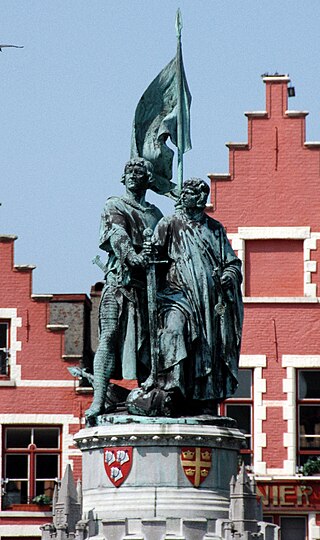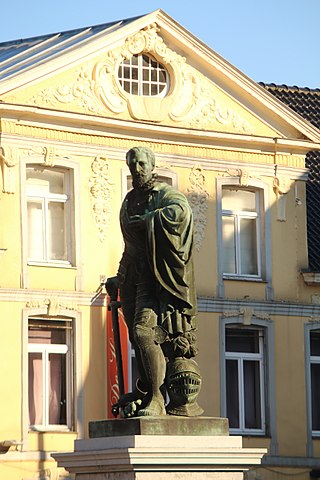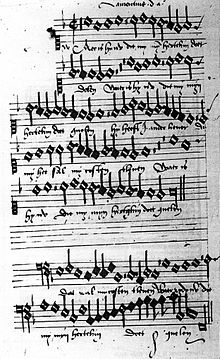
Jan Breydel is credited with leading the Bruges Matins, a violent uprising against Philip the Fair. He is said to have played a major role in the Franco-Flemish War, even though his authenticity has since been questioned.

François-Joseph Kinson, was a Flemish painter.
Petrus Vulcanius otherwise Pieter De Smet was a humanist scholar and local government official of Bruges.
Patricia Mary, Baroness Carson was an Anglo-Belgian historian and author.

Watervliet is a village in the Belgian province of East Flanders and suburb of the town of Sint-Laureins. Watervliet is part of the Meetjesland, and is adjacent to the Dutch border. It was a separate municipality until 1977.

The Exposition des primitifs flamands à Bruges was an art exhibition of paintings by the so-called Flemish Primitives held in the Provinciaal Hof in Bruges between 15 June and 5 October 1902.

The lords of Gruuthuse were one of the noble families of Bruges in the medieval period. It was one of several families bearing the title of "lords of Bruges" Their heraldic motto was Plus est en vous – Meer is in u.

This is a timeline of Belgian history, including important legal and territorial changes and political events in Belgium and its predecessor states. To read about the background to these events, see History of Belgium. See also the list of Belgian monarchs.

Eekhout Abbey was a medieval house of Augustinian Canons in Bruges, West Flanders, Belgium.

Male Castle, Bruges. A community of the Canonesses Regular of the Holy Sepulchre. It originated in Bruges in the 11th century, and between 1954 and 2013 was settled in Male Castle in Male, Sint-Kruis, Bruges, West Flanders, Belgium.
Philippe Veranneman de Watervliet was a politician in the Southern Netherlands. During the period of the United Netherlands he was a member of the Second Chamber in the States General. He was also, between 1828 and 1830, the last mayor of Bruges before 1830, when the southern part of the country broke away to form the separate state of Belgium.

Pieter Bladelin was an important financial advisor and civil servant to the Burgundian State. He was lord of Middelburg and built the Hof Bladelin in Bruges.

Johan Decavele is a Belgian historian and archivist who mainly published on the history of Ghent and of the Reformation. He was a contributor to the Algemene Geschiedenis der Nederlanden, Dictionnaire d'Histoire et de Géographie ecclésiastiques, The Golden Delta of the Low Countries, The Oxford Encyclopedia of the Reformation and Oxford Art Online.
Stephanus Gerardus Axters (1901–1977) was a Belgian scholar with a particular interest in the history and literature of Christian mysticism.
William Deken was a burgomaster of Bruges and leader of the 1323–1328 Flemish revolt against the count of Flanders and the King of France.

Jacobus van Eynde or van den Eynde was a Flemish organ builder.

Yolande of Dampierre, also known as Yolande of Flanders, Yolande of Kassel and Yolande of Bar, was Countess of Bar by marriage to Henry IV, Count of Bar. She was Regent of the County of Bar between 1344 and 1349 during the minority of her son Edward II, Count of Bar, and for her son Robert in 1352-1353 and 1356-1359.

Egmont's crypt is a crypt on the Market Square in the Belgian city of Zottegem. The crypt contains the remains of Lamoral, Count of Egmont and his wife Sabina, Duchess of Bavaria.

Egmont's statue is a statue of Lamoral, Count of Egmont in the Belgian city of Zottegem dating from 1872.

The archaeological museum of Velzeke is a museum located on the Paddestraat in Velzeke-Ruddershove in Zottegem, Belgium. It focuses on prehistorical times and the Gallo-Roman period. The museum opened its doors in 1972.















